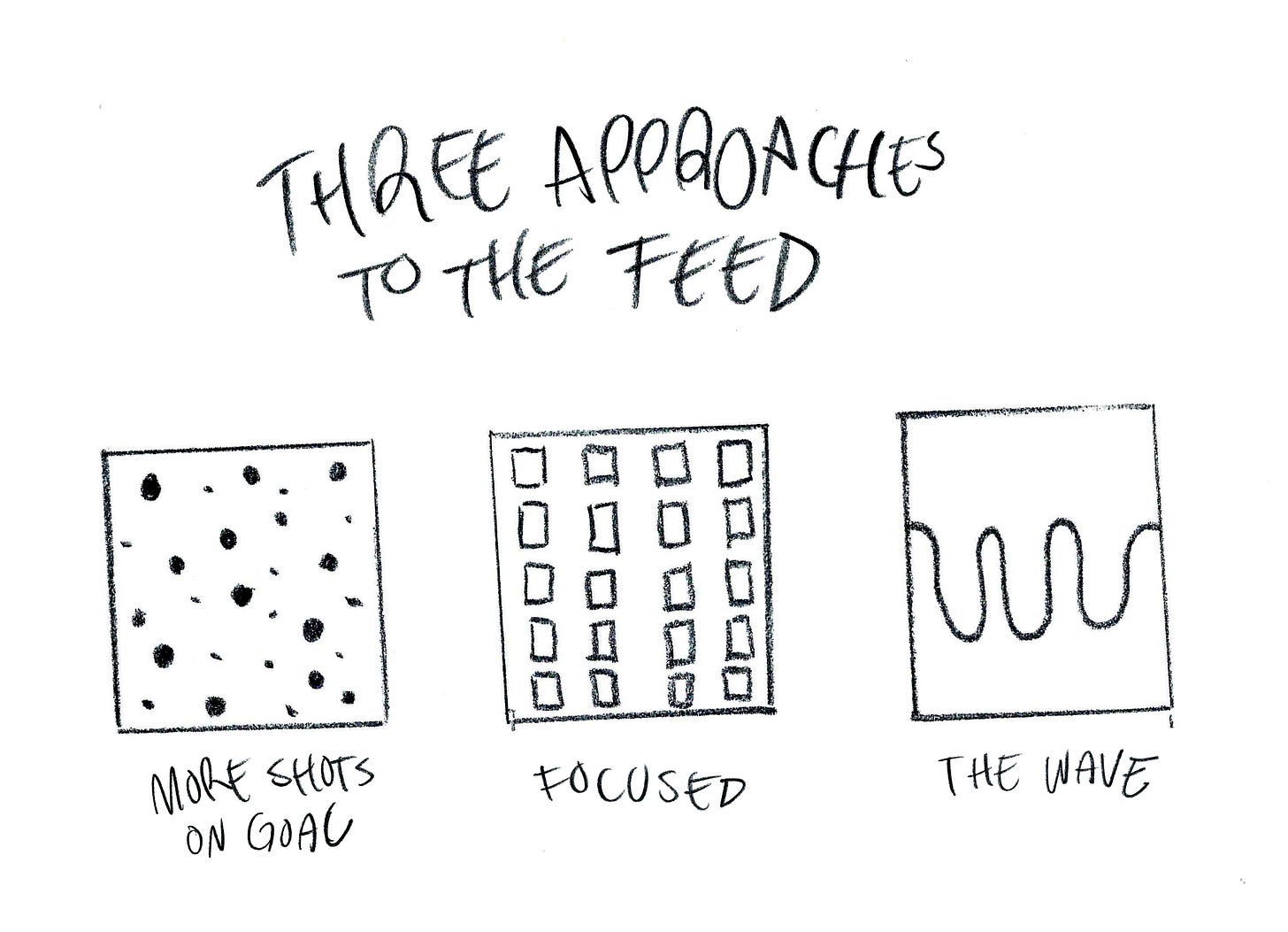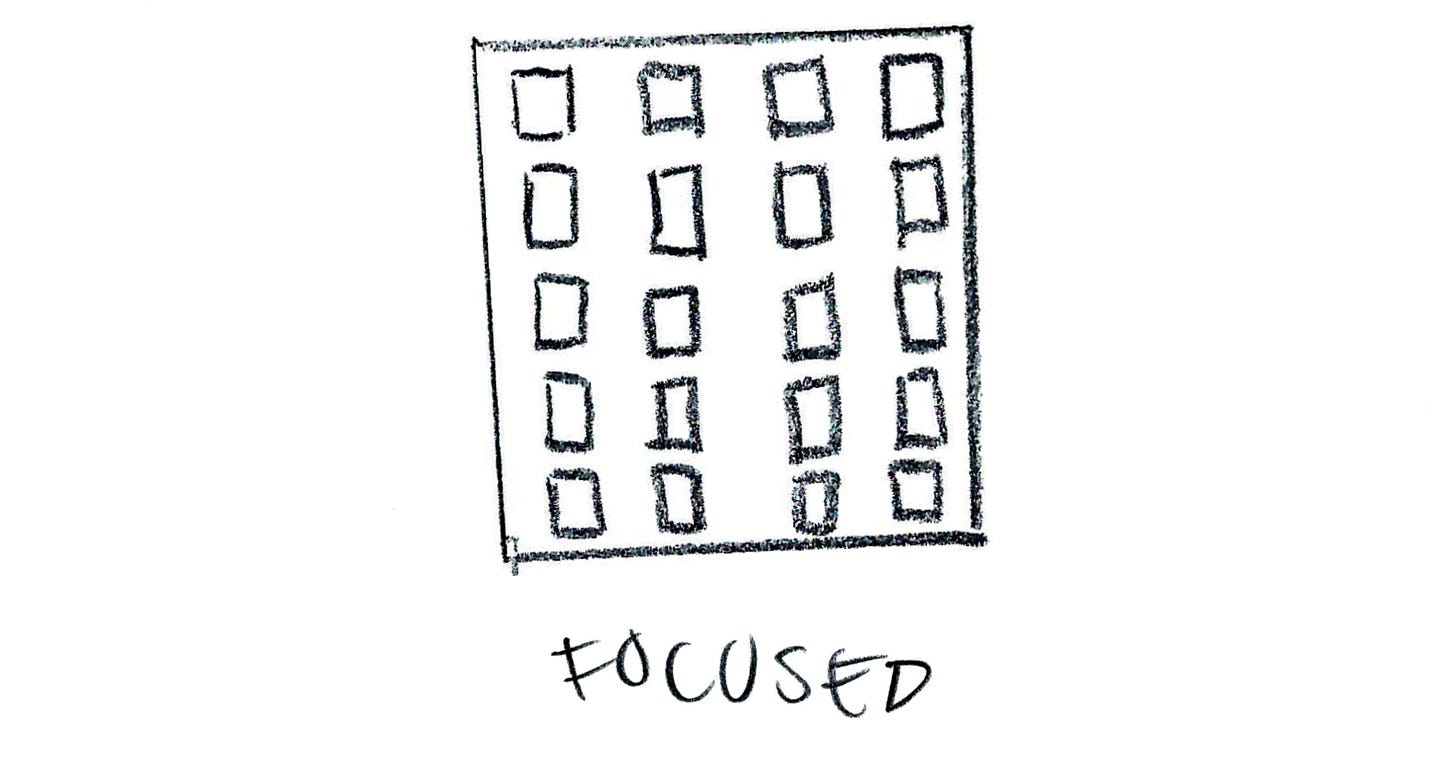Post-social media
It's time to rethink what the feed is for.
I’ve spent the past five years writing about social media. Specifically, how brands are using social media to reach audiences. In my research, conversations, and consulting, one question keeps coming up: Why don’t my followers see my posts?
Old Social vs New Social
With Old Social, the amount of engagement you’d get on a post felt somewhat predictable, playing within a set of boundaries dictated by how many followers you had. Sure posts would flop or take off, but day-to-day it felt like your core audience would see your content. This era was defined by a follower-based feed.
With New Social, your content either gets seen by no one or everyone. You can imagine your post as a car pulling up to two lanes. One is slow and one is fast. Old Social had a middle lane—views from your followers—but with New Social it’s gone. If the post isn’t shareable or appealing to non-followers, it immediately signals over into the slow lane. This era is defined by a recommendation-based feed.
Post-social media
When I look at recent posts from brands with millions of followers—accounts that used to be guaranteed engagement based purely off their size—I see videos with barely any views. Fortune 500s with 500 likes. Those who work on smaller accounts can feel it too. Why don’t my followers see my posts?
As
wrote in his very good essay Everything Is Television, “Social media has evolved from text to photo to video to streams of text, photo, and video, and finally, it seems to have reached a kind of settled end state, in which TikTok and Meta are trying to become the same thing: a screen showing hours and hours of video made by people we don’t know. Social media has turned into television.”The FYP ate the follower.
For brands, this mandate is tricky. On Old Social, accounts could use their feeds to provide updates, share product photos, and communicate with customers. Where does that live in New Social?
The bifurcation of brand social
The brands that succeed in New Social will split their social media strategy in two.
New Social requires brands to think of certain features within an app for awareness and think of other features within an app for community. If your feed is your front door, then your DMs are your dinner table. How do you make content that invites someone in?
Below is a sketch of the funnel Instagram shared with Link in Bio readers earlier this year. In it they broke their app down by features and what each one is for. It’s important to note that some of these features have their own algorithm—the Reels algorithm is different than the Instagram Stories algorithm.
Reels and Carousels are for reaching new audiences. (They get shown to non-followers.)
Carousels (again), Photos, and Stories are to engage your existing followers.
Lives and Broadcast Channels nurture your biggest fans.
Three approaches to the feed
I see three ways that brands will use the feed in New Social, each taking advantage of the recommendation algorithm in their own way.
The “more shots on goal” approach
If the purpose of the feed is to reach new audiences, then some brands will take a “flood the zone” approach. This strategy is already implemented by industries like sports, news, and media simply due to the sheer volume of content that they are working with. Now we’re seeing more unexpected industries try this too. The rise of clipping gives us a peek into what this might look like.
In a recent article in The Ankler, author Matthew Frank broke down how clipping is working in Hollywood. In one example, a producer on FX’s Adults paid Max Peterson, who runs a marketplace called Clip through a Discord channel, to disseminate clips from the show. “We basically put the whole season one in a Google Drive folder and gave it to these editors and clippers to kind of go ham,” Max told The Ankler.
I could see a world where every streaming service and movie studio has their own “clip” account—a feed where they are going more for scale than curation. The TikTok account What To Watch On Netflix, which appears to be run by Netflix itself, feels pretty close to this. Lionsgate recently hired fan edit creators to work on their social media strategy.
Financial operations platform Ramp found a lot of success from their recent livestream because of the hundreds of clips that spawned from it.
Meanwhile, brands like Graymatter and Sprout are seemingly working with UGC creators to create dedicated accounts that talk about them over and over and over again. The account @that_girl_in_a_blazer, which reads “Sprout ambassador 🤞” in the bio, often gets millions of views.
A big reason why brands previously paid a lot of attention to posting cadence on Old Social was to not show up too often in their followers’ feeds. With New Social, that is less of a concern. It’s a game of hitting the algorithm jackpot, and, for some brands, taking more shots on goal will be the answer to winning big.
The focused approach
Serialized content thrives in New Social. Recommendation-based algorithms use signals to get a sense of whether you’d want to watch more content from a user you engage with or share a video from. When you get served their content again on the next scroll, are you more likely to watch if the content feels completely different than the video you liked or are you more likely to watch if it feels within the same world? I’d imagine it’s the latter. Much like a TV show, the goal is to retain viewership.
Little Joy, a small coffee shop Minnesota, told me “The algorithm seems to value episodic content 10x over one-off videos”. Brands like Craighill, InStyle, The Cheese Store of Beverly Hills, tldv.io, and Alexis Bittar have benefitted from this approach.
Bilt’s show Roomies just wrapped its first season, garnering an impressive 28M views across Instagram and TikTok. Los Angeles Public Library recently shared with me that they are turning one viral video into an entire series. The one-off becomes episode one.
As Adam Faze, co-founder and “Head Coach” of Gymnasium, recently summed up, “Brands are TV networks. And making shows that organically reach Gen Z on the platforms they watch is the future of marketing.” His company just co-created the show GIRL ROOM with Amazon Prime as a spin-off to their 100M+ view BOY ROOM.
The pushback I hear from social teams on this approach is that they can’t fit brand messaging or sales tactics into a series. To that I say, maybe that’s okay! But I understand their point and believe that there are ways to create “shows” that can also be containers for brand updates. Both Little Joy and Craighill told me they have seen a lift in sales from the success of their serialized approach, with Little Joy seeing a 40% increase in revenue YoY.
The wave approach
The wave approach is where we see most brands sit currently. They post evergreen content that often feels more geared towards existing followers than new ones and then use big campaign moments to break through. Their engagement goes up and down depending on the type of post.
The brands that take this approach are comfortable with this oscillation of reach because it means they still get to post about all of their brand pillars. Their presence feels curated. It leaves room for messaging levers to be pulled. They can build campaign-specific worlds.
I do think that big brands—ones that have already found their footing in culture and have existing brand awareness—are more likely to find success with this approach. The Dunkins and Nikes and Gaps. These brands prioritize newness and newsiness, rolling out big campaigns and moments on a frequent cadence. It works!
When it comes to smaller brands that have less budget and resources, I’d flag that it can be harder to reach new audiences with this strategy.
About that dinner table
Earlier I wrote that if your feed is your front door, then your DMs are your dinner table. Or your Broadcast Channel. Or your Close Friends.
With New Social, we’ll see brands invest more deeply in areas where they can nurture relationships with their biggest fans.
There’s Glow Recipe’s very active Broadcast Channel with over 37K members. The RealReal’s fun-to-read Substack that gets sent out to over 4,000 subscribers. Topicals’ customer casting call. Away’s Close Friends strategy. Tory Burch’s TikTok Bulletin Board bag release. Owala’s fan-fueled in-person events.
While the surfaces for scale will require one strategy, so will the surfaces for social. Actual social. The social that’s been left behind. It will become more important than ever to create spaces—especially offline spaces—to connect with the people who love your brand.
A happy note
Last week, I got a note from reader Danielle Schwab, who runs @illuminate_food, an account dedicated to beans. She said, “Hi! I’m a fan of your work and just wanted to share my story that a very simple carousel post about beans went viral for me a couple of weeks ago and restored my faith in the algorithm as it connected me with almost 25k bean lovers. It was all very wholesome and surprising and still trying to figure out what it means. But when people say the algorithm is dead I now have experienced that’s not true! It actually connected me with the right people!”
It’s easy to feel like these platform changes mean that only a certain subset of posts will “work”. Rage bait brain rot. It’s not true! Make that post about beans.
I share all of this not as an endorsement of where these platforms are going, but an acknowledgement of what they are. Knowing the rules makes us better strategists. When to follow them and, more importantly, when to break them.
If you enjoy free newsletters like this one, you can upgrade to a paid Link in Bio subscription. You’ll get weekly strategy newsletters and quarterly trend reports, along with access to the Discord community.
One member shared, “The Link in Bio Discord has been an absolutely invaluable part of my growth as a social media professional. It’s allowed me to meet so many fascinating and talented folks in an industry that can often feel like living on an island, and helped me contextualize a lot of the mysteries of social.”
It might even be an educational expense at your company! Here’s a template for you to use when asking.












This is great! As far as the focused content goes, I couldn't agree more about social series taking over feeds. It's interesting to think about if we'll see product placements in these shows like we do in regular TV shows or if we'll see brands disrupt these shows with "commercials".
Incredible input as always